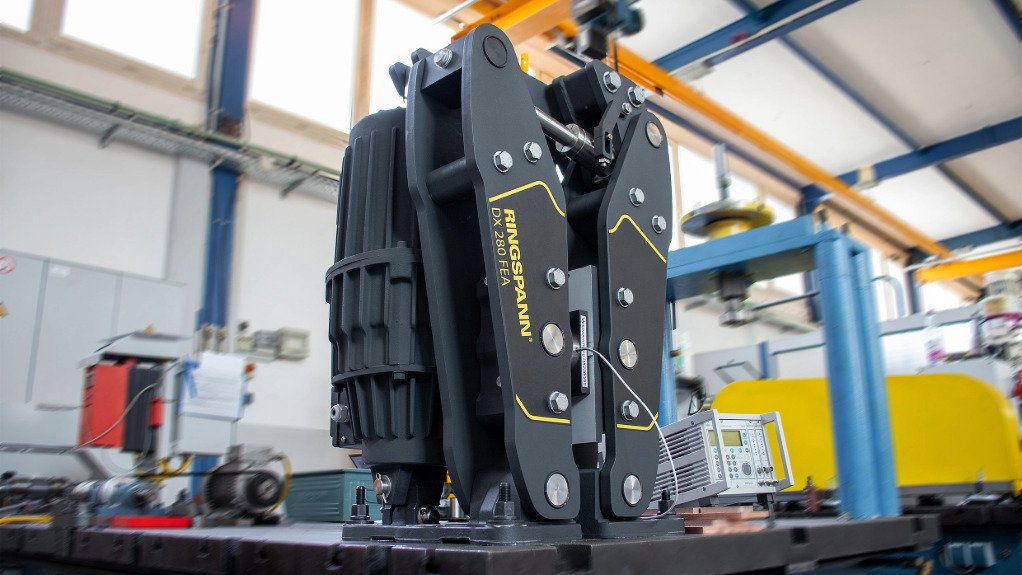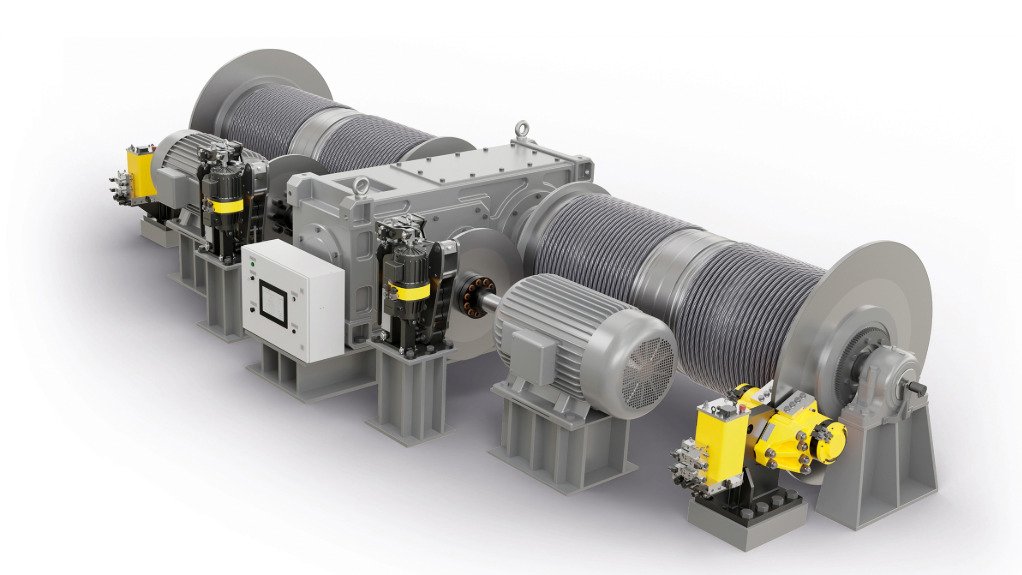Following extensive re-engineering and a complete revision of their design, power transmission components specialist RINGSPANN has launched its flagship DX series electro-hydraulic disc brakes as a “trendsetter” in the field of electro-hydraulic holding and emergency stop systems.
Specifically developed for use in the hoisting and travel drives of conveyor belts, cranes and bucket wheel systems, the DX series is designed for a high number of switching cycles on high-speed brake discs.
The electro-hydraulic disc brakes in the DX series are spring-operated, fail-safe brakes, closing during power interruption and opening through the thruster. Designed for high switching cycles on high-speed discs of 500 mm to 1 000 mm in diameter, they deliver clamping forces of up to 80 kN, depending on the variant.
Featuring a slim steel construction, a newly designed angle lever and energy-efficient thrusters, the DX series offers significant benefits to original equipment manufacturer (OEM) designers, operators and maintenance personnel of such systems.
“The primary goal in the re-engineering of the electro-hydraulic disc brakes of our DX series was to create an economical and convincing solution in every respect for the realisation of assembly-friendly, user-friendly and service-friendly holding,” says RINGSPANN brakes business developer Martin Ohler.
To meet this requirement, Ohler and his team carried out several benchmark assessments, market analyses and customer surveys, ultimately resulting in significant specifications for a fundamental revision of the previous design of the DX series.
Additionally, they set the course for several optimisations, which have earned significant praise from experts during the first presentations of the new DX brakes, reports RINGSPANN.
The company highlights three factors that could make the new DX series best in class in the company’s brake portfolio.
Firstly, designing important components, such as the brake lever, using flame-cut steel instead of cast iron, ensures a low unit price and simplifies the brake’s maintenance, servicing and general overhaul while providing a slim design of the brake.
Secondly, to protect brake levers and bushings from bending and torsional forces, the angle lever – which connects the thruster, brake spring and brake levers – has been designed to have the same high torsional rigidity as cast iron counterparts. This also makes it easy to assemble and replace owing to fewer parts.
Thirdly, the brakes can be equipped with various, partly-new and energy-efficient thrusters from RINGSPANN’s own production, while their indented installation contributes to the compact design of the brake.
“Overall, our new DX brakes have surprisingly small envelopes. This means that they are space-saving and fit well into existing environments. In addition, they can be exchanged for other models without modifications.
“As part of the re-engineering, we have also equipped the DX brakes with numerous detailed solutions that make it easier for OEM designers to integrate the brake into their drive system and offer many advantages to both plant operators and maintenance, repair and operations personnel,” he says.
DX 280 FEA Features
The DX series’ top model – the DX 280 FEA – provides additional key functional features, with the brake pad’s wear compensation being capable of being adjusted manually or automatically through a maintenance-free freewheel, ensuring consistent high clamping force by compensating for the operationally-increasing distance between the brake pad and the brake disc.
The standard, maintenance-free self- centring feature ensures both brake levers open synchronously along with ensuring the air gap on both sides of the brake disc remains equal, even if the brake pads continue to wear.
An additional mechanism ensures the pads remain parallel when ventilated and maintain uniform distance from the brake disc, independent of the brake levers’ V-position. This mechanism can be easily adjusted with adjusting screws.
The DX 280 FEA’s thrusters are suitable for braking torques from 1 700 N to 28 100 N and clamping forces from 22.5 kN to 80 kN.
This releases the brake through an electro-hydraulically-generated counterforce to the brake spring. To build up this power, an electric motor, an impeller or gear pump, and a piston cylinder interact in each of their compact housings.
“Which thruster, with which type of pump is preferred, depends on the specific requirements for the brake. Important parameters here include opening and closing times, energy efficiency, maintenance costs and price,” says Ohler.
In particular, the TH UEK 475 thruster has a gear pump that can generate high pressures with a low oil volume. When the brake is open, it switches to pressureless circulation, which reduces power consumption and wear, and enables fast closing times of less than 80 ms. It also works analogue without the requirement of a control card.
Further, the thrusters are easy to replace as their solenoid valve coils are mounted externally.
Edited by: Donna Slater
Features Deputy Editor and Chief Photographer
EMAIL THIS ARTICLE SAVE THIS ARTICLE
ARTICLE ENQUIRY
To subscribe email subscriptions@creamermedia.co.za or click here
To advertise email advertising@creamermedia.co.za or click here















